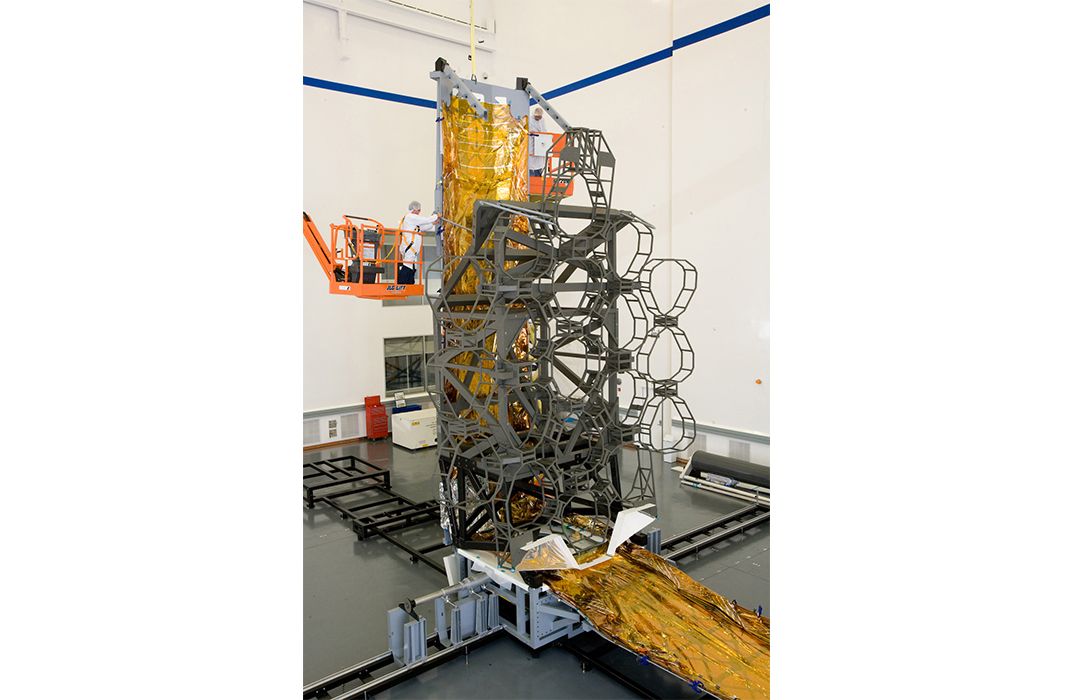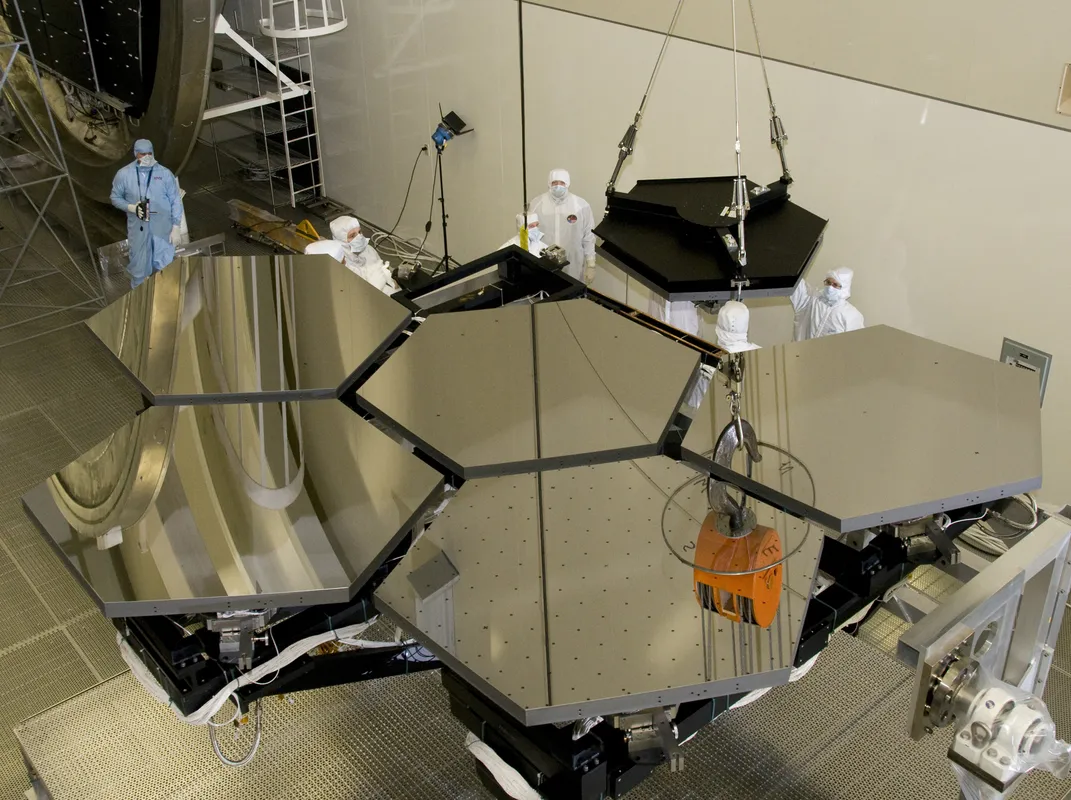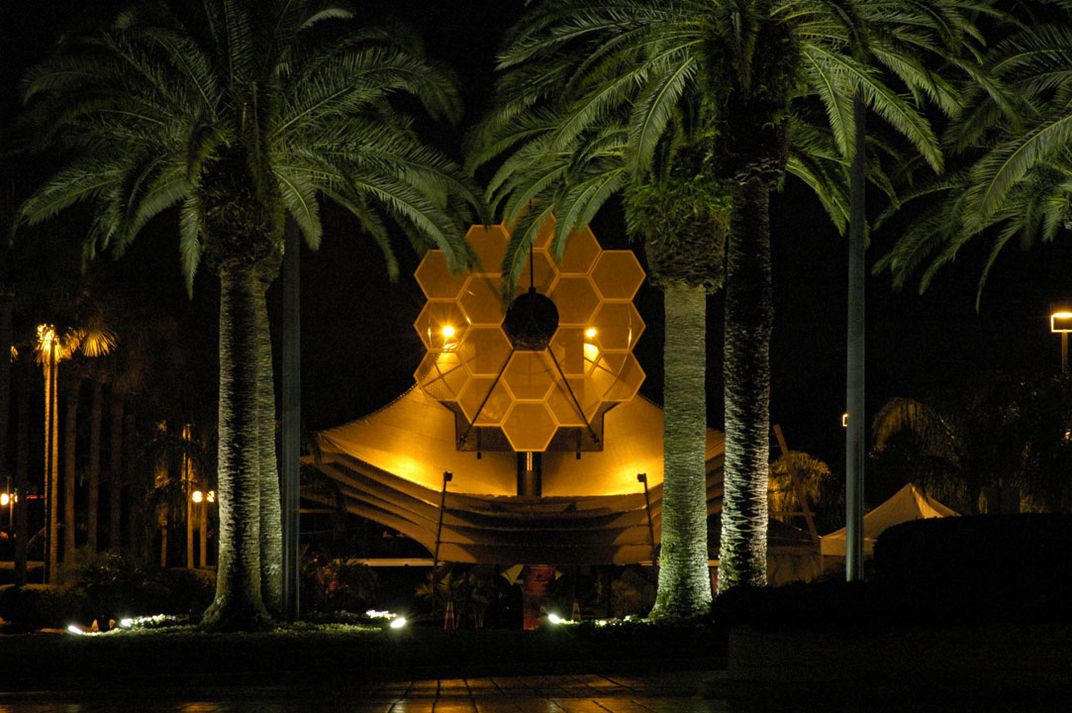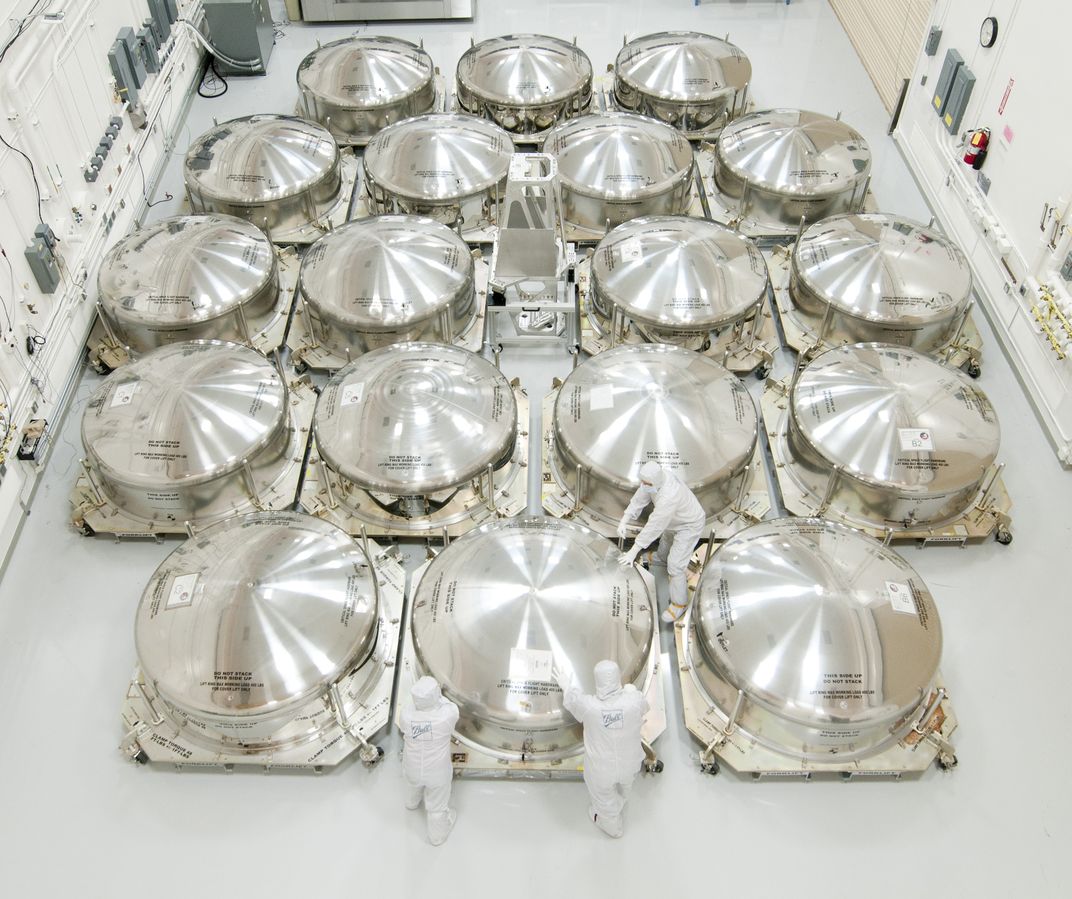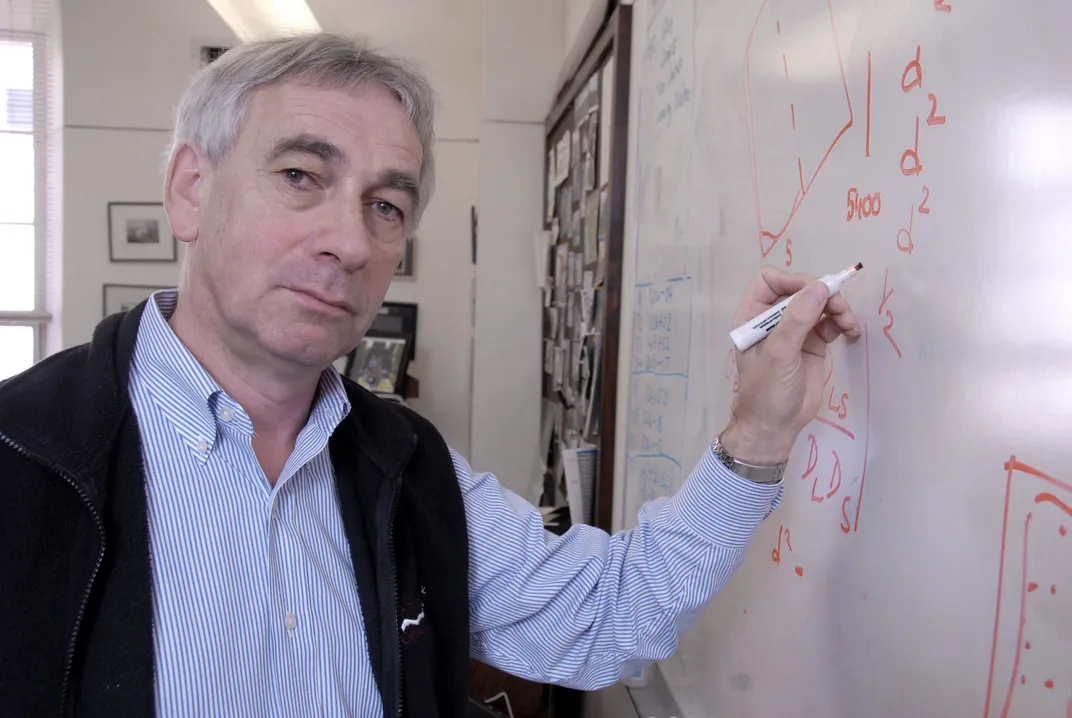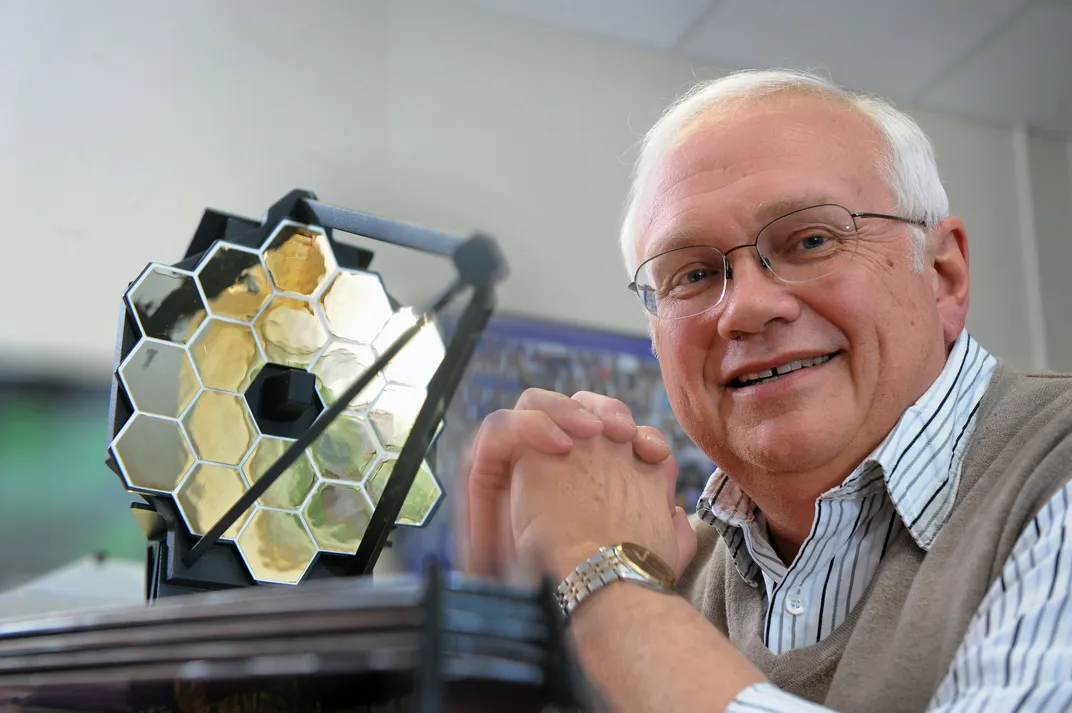Infrared Dawn: The Next Space Telescope Will Be Hubble x 100
The James Webb Space Telescope will see out to the universe’s edge.
:focal(1202x523:1203x524)/https://tf-cmsv2-smithsonianmag-media.s3.amazonaws.com/filer/b9/4f/b94f930c-ee24-4009-8c4b-9cb8087d11d1/11f_jj14_mirror_segment_live.jpg)
On a rainy Monday morning in early 2014, Senator Barbara Mikulski of Maryland joined NASA Administrator Charles Bolden on a stage at NASA’s Goddard Spaceflight Center in Greenbelt, Maryland, to congratulate the team building the James Webb Space Telescope on having cleared a hurdle familiar to anyone who’s just arrived home with a box of furniture from IKEA: making sure all the major parts are there.
All four of the scientific instruments NASA’s new flagship observatory will carry—built by the European Space Agency, the Canadian Space Agency, the University of Arizona, Lockheed Martin, and NASA—had arrived. Ball Aerospace had delivered all 18 hexagonal segments of the observatory’s honeycomb-like, 6.5-meter primary mirror, designed to look into a past 13 billion years distant. From an observation platform, you could see one of the mirrors on display in the Spacecraft Systems Development and Integration Facility, the largest clean room in the world. Others sat in their custom shipping crates, each one like a stove-top popcorn tin the size of a large kiddie pool.
Two decades after astronomers first convened to discuss what sort of space-based observatory should succeed the Hubble Space Telescope, Hubble’s three-times-as-large, 100-times-as-powerful replacement, whose fabrication was overseen by primary contractor Northrop Grumman, finally seemed to be coming together. “Going from Hubble to the James Webb Space Telescope is like going from a biplane to the jet engine,” said Mikulski, who has long been the project’s strongest legislative advocate—and who four years earlier had called for an independent panel to uncover the causes of its delays and ballooning expense.
That panel published its findings in October 2010, concluding that NASA had, in essence, requested an indie-movie budget to make a high-tech blockbuster. It praised the quality of NASA’s technical innovations while criticizing its management. NASA responded with a dramatic “re-plan,” establishing a schedule that now has Webb slated for launch in October 2018, at a grand total of $8.8 billion—more than eight times the amount NASA estimated when work began nearly a generation ago.
Bill Ochs, who came on as project manager late in 2010 to implement the re-plan, says that the Webb has stayed essentially on schedule—though now an especially tight one—during his watch. “Instruments are typically one of your high-risk items,” Ochs explains in his office at Goddard, where a shoe-size model of the telescope sits on a side table next to miniatures of other satellites he’s worked on in the last 30 years. “So to have them delivered here almost five years prior to launch is just outstanding.”
Or almost four years after the launch date anticipated by the decadal survey of 2000, in which astronomers named the Webb telescope their top priority. At least the launch has finally seemed to stop doing what the objects Webb was built to observe are doing—receding ever farther into the cosmic distance.
In 2002, the space telescope was officially named after James Webb, a Marine Corps pilot who served as the space agency’s administrator from 1961 to 1968, overseeing the Mercury, Gemini, and Apollo programs. “There’s no other project on the table even 20 years out that can do what [Webb] should be able to do,” says James Dunlop, a professor of extragalactic astronomy at the University of Edinburgh, Scotland. “Sometimes people want to can these projects because in the meantime some new, cheaper technology breakthrough is made that renders the facility obsolete before it’s even flown. There’s no danger of that happening with James Webb.”
No one disputes that the Webb will be an extraordinary machine, one that will allow astronomers to look farther back in time than they’ve ever been able to see, to the earliest galaxies that formed after the Big Bang. The gold coating on its mirror segments, totalling about a golf ball’s worth and spread in a thin layer across the surface of each segment, will absorb light on the blue end of the spectrum, allowing the observatory to see a bandwidth between 0.6 to 28 microns, firmly in the infrared and stretching just slightly into the visible spectrum.
Scientists have known since Hubble was launched that its successor would need powerful infrared capabilities. Advances in knowledge made during the Webb telescope’s long gestation—the discoveries of thousands of extrasolar planets, for example—have served only to underscore the scientific need for a cold, infrared-optimized observatory in space.
For viewing faint, distant stars and galaxies, infrared is where the action is, because the expansion of the universe extends the wavelength of light over time. This phenomenon, known as redshift, gradually stretches visible light waves outside that part of the spectrum, beyond where Hubble (which has some infrared capabilities but captures mostly visible and ultraviolet light) and even the infrared Spitzer Space Telescope can register. Like Webb, Spitzer is a cryogenic telescope with a beryllium mirror, but less than one meter in diameter—“a tiny little tiny can,” as Dunlop puts it. “At the relevant wavelengths, [Webb] has a collecting area 100 times greater than the best facility we have,” he says. “It’s an order-of-magnitude jump in what we can do.”
Simon J. Lilly, a professor at ETH Zurich, a university in Switzerland, who was part of the committee that in the mid-1990s advised NASA on what was then called the Next Generation Space Telescope, is just as enthusiastic. “The current frontier for reliable detection is not much beyond redshifts of seven,” he says, using the redshift formula in which the higher the number, the more distant and earlier in time the object. “The very first objects, I think, are probably actually beyond reach even of [the Webb]. But I’m optimistic that we might get back out to redshifts of 15—substantially beyond where we have any information today.”
Assuming all goes according to plan, Webb will see first light in early 2019. It will be sent to orbit about the L2 Lagrange point, a gravitationally stable location 930,000 miles from Earth. The orbit was selected because at that distance, the telescope’s sunshield can block heat from both the sun and Earth, preventing it from interfering with Webb’s observations. Besides, an orbit around the sweet spot where sun and Earth gravity are in balance requires little fuel to maintain. Though designed for a minimum mission life of five years, not including travel and cool-down time, Webb will carry enough propellant to hold that orbit for at least a decade.
Mike Menzel, Webb’s mission systems engineer, says the telescope’s engineering challenges have been what he always knew they’d be: its cryogenic temperature (Webb will operate at 50 Kelvin, or -370 Fahrenheit) and the need to make both the sunshield and the primary mirror deploy. “Things tend to ring like a bell when they get cold,” Menzel says. “Vibrations carry through these structures. You’ve got a six-meter telescope and you’ve got all these actuators on the spacecraft” for adjusting the mirrors. “Spinning wheels. Cryo-pumps. You’ve got to make sure their vibrations don’t jitter the telescope.” Menzel cues up a video clip on a monitor, showing a “sine vibration test” submitting a Webb component to forces similar to those it will be exposed to during launch. “Optical engineers get nauseated when they watch this,” he says, chuckling.
Soon after launch from Kourou, French Guiana, the giant observatory will begin to carefully unfold itself from its ESA-supplied Ariane 5 launcher. On its straight shot to L2, Webb will unfurl its solar arrays just 33 minutes after leaving Earth. Two days later, the five layers of the tennis-court-size sunshield will deploy, a slow, careful unspooling that will take about 72 hours. The flower-like primary mirror deploys on day 11, less than halfway before the observatory reaches its destination on day 29. Meanwhile, “almost three and a half metric tons of material have to be cooled to around 50 degrees Kelvin,” Menzel says. “We’ve never launched anything of this size to that temperature.”
Another stringent requirement for a telescope that will see back to the dawn of time: The surface of each primary mirror segment must stay within 25 nanometers of its smooth, polished shape. (A sheet of paper has a thickness of about 100,000 nanometers.) To this end, manufacturer Ball Aerospace made the segments from beryllium, a lightweight, toxic element, chosen because at very low temperatures it behaves so predictably. When lowered to cryogenic temperatures, beryllium, like most materials, warps; unlike other materials, beryllium warps in a consistent, easy-to-predict way. During cryo-testing, the mirrors were subject to drastic fluctuations while being repeatedly cooled from room temperature (at which the electrically heated Hubble operates) to its operational temperature in space. Engineers made a topographic map of the surface of each mirror segment. “Where it went high, we polished low, and where it went low, we polished high, at room temperature,” says Ball’s Mark Bergeland. “So every subsequent time they go cold, that nulls itself out and you get that nice, smooth optical surface.”
Besides its ability to pick up faint, faraway objects, Webb’s infrared capability offers another benefit: Infrared light penetrates the molecular clouds of gas and dust better than visible light does. Those clouds are where stars form. “We initially thought of having an infrared-optimized telescope to look for highly redshifted, very distant galaxies,” says Jonathan Gardner, the Webb’s deputy senior project scientist. “It also turns out to be very good at studying the formation of stars and planets in our own galaxy.”
The birth of stars and their proto-planetary systems is one of the four main science areas that Webb’s suite of near- and mid-infrared imagers and spectrographs will study. The other three are: the formation of galaxies; exoplanets and their potential for harboring life; and the universe’s re-ionization, when the first light shone, a mere 500 million years after the Big Bang.
In 2012, California Institute of Technology astronomer Richard Ellis headed up the Hubble Ultra Deep Field project. That survey looked farther back than any other toward the cosmic dawn, whetting astronomers’ appetites for what Webb will show them. “We found there are galaxies seen when the universe was, say, seven or eight hundred million years old that were not recent arrivals; they’d already been there for one or two hundred million years,” says Ellis. “That’s very exciting, because that means that there are even earlier objects that are currently beyond reach…. James Webb will be able to find them.”
For a younger generation of astronomers, the Webb telescope has been part of the conversation for as long as they’ve been in the field. Zachory Berta-Thompson finished his Ph.D. at Harvard only last year. Now a post-doctoral fellow at the Massachusetts Institute of Technology, he’s excited about the Webb’s capabilities for researching the conditions of planets orbiting distant stars. Using Webb’s Near-Infrared Imager and Slitless Spectrograph, NIRISS, astronomers will be able to collect the light emissions as an exoplanet moves in front of its host star, and from that data, determine the composition of the planet’s atmosphere.
Like Hubble, the Webb telescope will be primarily an open observatory: Anyone can submit a proposal to use it. Hubble’s time is allocated in 90-minute increments because that’s how long it takes the telescope to orbit Earth. The Webb, traveling around the sun in sync with Earth, will take a year to complete one orbit, so the allocation committee will have to dole out its use in some not-yet-determined slice of time, according to Gardner.
He says Hubble’s committee receives six to eight times as many proposals as it can accommodate. Dunlop, who with Ellis was on the team that obtained the Ultra Deep Field images from Hubble, believes the competition for the Webb will be even tougher than that. He already has Ph.D. candidates doing prep work for the proposals they’ll submit in a few years, using computer modeling to project what present-day galaxies must have looked like billions of years earlier, based on calculations of the expansion of the universe, the lifespan of stars, and other factors. They’ll hope to use Webb observations to confirm or refute their theories.
A global explosion of interest in astronomy has made the process of applying for time on one-of-a-kind observatories far more competitive than it was when Dunlop started his career, in the early 1980s. “The research community is at least 10 times bigger than it was two decades ago,” he says, and the increase has driven a “sociological evolution” in which investigators must band together into ever-larger teams to increase their likelihood of winning observing time. “When I started in astronomy I wrote a lot of one- and two-author papers,” says Dunlop. “Now they rarely have less than 10. A lot of the big astronomy papers now typically have like a hundred authors.”
For the Ultra Deep Field, Ellis and Dunlop won the observing time on Hubble in part by promising to make their data public after only three months. But their applications for followup research with Spitzer have been declined twice. Ellis suspects that one reason is the allocation committee’s awareness that the Webb telescope will be a far more efficient tool for the kind of infrared survey they want to make.
“I think that’s kind of a foolish approach because, heaven forbid, it’s possible that something could go wrong with James Webb,” Ellis says. “You should never wait for something that hasn’t been launched. Also, if you do ambitious work with Spitzer, you probably will learn something that will help you better utilize James Webb.” He’s wary that the run-up to the new telescope’s deployment will have a chilling effect on other observations. “As we get closer to the launch of James Webb, maybe even programs with Hubble will be deferred, which I think would be a shame.”
While the Webb telescope will be, in Berta-Thompson’s words, “an excellent, all-purpose, figuring-things-out machine,” astronomers did not get everything on their wish list. “I guess if I had my druthers, I would optimize things a little bit better for studying very bright targets,” Berta-Thompson says. Astronomers who focus on distant galaxies at high redshift, however, like Lilly does, approve of Webb’s optimization for faint objects. But even they can’t have everything. “I was sad when the mirror went down from eight meters to six and a half many years ago,” before the contract with Northrop Grumman was finalized in 2002, Lilly says.
Lilly points out that one project he was involved with, the Cosmic Evolution Survey (COSMOS), was the longest observation ever to win time on Hubble. Creating a deep mosaic of visible light in a two-degree region of the sky, using Hubble’s Advanced Camera for Surveys, took 640 orbits—about 1,000 hours—over two years. “If Hubble had had instruments with a field of view twice as large, it would’ve taken half as much observing time,” he says. “Ironically, the decision to halve the field of view on [Webb’s Near-Infrared Camera] was taken at almost exactly the same time” as COSMOS’s findings demonstrated the value of a more capable near-infrared camera for the observatory. “What can I tell you,” Lilly sighs. “That was unfortunate.”
He recognizes that compromises between cost and capability must be made. “One of the things which has been said which is not true about Webb is that there has been capability creep—that the astronomers always wanted more,” he says. “From my perspective, that hasn’t happened.... Often capabilities which one would’ve liked to have had were reduced.”
Ellis thinks that one element that has contributed to concern over the Webb telescope’s cost is the lingering memory that Hubble’s mirror turned out to be shaped incorrectly, a fact that went unnoticed until after its launch. Only after the first servicing mission, in December 1993, three years after the launch, when astronauts installed a pair of corrective optical devices, was Hubble able to realize its potential. In its L2 orbit, Webb will be four times as distant from Earth as the moon, beyond the reasonable reach of manned repair should something go wrong.
But Menzel points out that building something to be effectively unbreakable within its planned life is the rule, not the exception. “The truth is, for almost 50 years, the majority of spacecraft we launch have not been serviceable,” he says. “And they’ve lasted perfectly fine without servicing.”
Still, the Webb telescope has a lot to prove. Its cost has taken money away from other NASA science projects; it’s years behind its original schedule and vastly complex, and if something goes wrong, it would be a bust. Phil Plait, once an astronomer who got observing time on the Hubble telescope, now writes a popular column for Slate called “Bad Astronomy.” He echoes a common refrain from astronomers: Hubble also took longer and cost more than NASA said it would. Haven’t the discoveries Hubble made possible been worth it?
“A few years after launch most people won’t even remember all this,” Plait said via email. “Hubble had very similar problems, including a devastating equipment flaw that held up most science for two years (as I well know; I was using Hubble then) and which was a massive PR disaster for NASA. Within a few years after the problem was fixed, people had more or less forgotten, and it’s now an icon of astronomy and NASA. The same could well be true for [Webb].”
And in a mere half-decade, just think of the wonders we’ll see.
